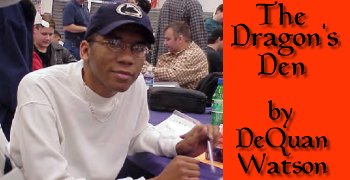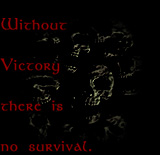|
|
 |
 |


The Gypsy is Here
www.AGypsy.com
This new program just might be one of the most
revolutionary items for the game of Magic: The
Gathering. Itís been in development for a while
now. It finally goes online this week. It
can possibly level the playing field between mediocre
and strong players. It can easily eliminate
anywhere from 10-20 hours from your playtesting time.
Itís a good quick reference tool and great to
help you deck build.
I guess with all this hype and rambling, many of you are
wondering exactly what this program is. The
program is going to be run from a secure set of servers
and be run through a website (Donít worry, this
doesnít hurt the speed of it at all). The site
is being referred to as a "deck building advice web
site," and honestly, that is probably the
single best explanation for what it is.
The program breaks down the cards, deck building
process, and even does a deck analysis for you. It
does all of this by breaking the program into three
different sections. Letís take a look at what
all they offer.
"The Seer"
This section is the first one to mess with. This
section allows the user to find cards by set, abilities,
and colors. The best part about this section is
that it is broken down within each type. You can
looks up items by card types. You can even get
specific. You can set the program to bring up all
Black, land destruction cards from Odyssey if you want
to and it will bring up a full set of results. After
the results are brought up, they are listed with what
they do in addition to a numerical rating. Analyzing
over a hundred different criteria on each card creates
the ratings. This does cause some ratings to look
a little funny on some cards (which are usually highly
specialized), but thatís ok. After they are put
into decks and different cards are put together or
tested the final deck ratings come out ok. This
can help you find all the different cards that do what
you are looking for and figure out which better suits
your needs.
"The Gypsy"
This section is where most of the deck building occurs
and is probably the most important. This deck
building software takes a little bit of work to get used
to. I spent about two hours on it to get it down
to a complete understanding. Once I did though, I
was able to drop decks into the system with amazing
ease. This section is broken into grids. There
are ten grids that have slots for up to ten decks.
This generally means that you can have up to 100
decks. To save you a few questions, the grids are
made to hold a 60-card deck and a 15-card sideboard.
Yes, this means that you can not put in a 250 card
Battle of Wits deck. The main reason for this is
that it doesnít fit most of the parameters and
equations that would allow the program to develop and
proper rating for the deck. While deck building
you can still bring up a variety of different cards with
their explanations to look at what they do before adding
them to the deck. The search engine when looking
up cards is really good. It accepts partial
spellings to bring up the cards you are looking for.
The one thing to note while deck building is that
you need to click on the card name to bring it up first,
then add it to your deck. The best part about this
section is the deck-analyzing portion. It takes
your deck and looks at it based on two different styles,
these being points and finesse. Points looks at
your deck needing to kill your opponent the traditional
way by reducing their life total. Finesse looks at
your deck needing to win by some other criteria. Finesse
generally needs more emphasis on card advantage an
utility spells like Wrath of God and Propaganda, while
Points decks refer more to creatures and damage spells
like Raging Kavu and Fireball. In the analysis,
you can look at your decks numerical percentages on
different aspects that can help dictate how often you
should draw certain things and how things should effect
the deck. If you DSR (Deck Strength Rating)
isnít real high, you cut your playtest time here by
going back to the drawing board and adjusting a few
things.
"The Player"
This is the last of the three sections. This is a
very intriguing section to look at. This section
of the site actually has quite a few uses. It has
what it calls an "interplay analyzer." First
of all, it allows you to shuffle decks based on your
shuffling style Light, Heavy, and Super. The
more shuffling you do, the better randomization you get.
After shuffling, you can review the results for
any number of hands drawn between one and one hundred
hands. This can be used for a variety of things.
I have used it to try and figure out my mana
situation by trying to decide how often I would mulligan
my opening hands. It also allows you to look at
the first few draws beyond your opening hands. It
looks at your first sixteen turns. This helps you
verify deck consistency, strategy, and timing. this
section also runs what it calls a "PDR
Summary." PDR is short for Play Damage Ratio.
This allows you to check your percentage of damage
being done one each turn. Within the PDR summary,
you can call up your previously shuffled and drawn hands
for review. Another cool part about this section
is its combo summary. It allows you to call up
particular combinations and cards and tells you how
frequently they would come up. For instance,
assume you were playing a Fires deck and wanted to have
a mana creature, a land, and a fires by turn two, you
would simply put in Birds of Paradise, Llanowar Elves,
all of your various land and Fires of Yavimaya. Then
the program would tell you how often the combo would
come up by the required turn. Another interesting
thing to do is to analyze the opening few hands for two
different decks with two different windows open. This
can be really good for planning out games against
particular bad matchups.
Admittedly, this program is not going to replace old
fashion playtesting. However, it can very well
save people time while deck building. The
websiteís largest claim is that it saves time while
building winning decks. If you want to do an
interesting test, take the previous winning decks from
various Pro Tours and look at how well they placed in
comparison to the other decks in the event. The
results are actually pretty amazing. They some up
almost how you would figure. Of course there are
cases where particular sideboard cards, or bad deck
matchups skewed the results and some players didnít
place quite as high, but that comes back to matchups.
Also, as a side note of interest, the program doesnít
support anything older than extended. The main
reason being that many Type 1 cards would be off the
scale for what they do and too many decks would have
insane ratings. Also, the card lists donít
evaluate cards that were released prior to extended.
This program should turn out to be useful to players to
all skill levels. There are a variety of players
already looking into it. The company took a couple
of opportunities to give some free demos of the game to
the general public. they took a moment to do so at
Grand Prix Houston. They gave free demos of the
game this past weekend at our local Pro Tour Qualifier.
The program has tons of ins and outs to learn.
There is a short learning curve to it, so you will
want to tinker with it a bit to get efficient with its
controls. There shouldnít be anything on there
the average player canít handle though.
Iím sure many of you have gotten this far and are
wondering how to gain access to the program. Well,
itís simple you have to pay for it. Itís not
what you would think. It is only $9.95/YEAR!!
Thatís not a typo, it is actually $9.95 for a
full year if you sign up by April 30, 2002. All
you need is a credit card and your set. It even
has a tracker on the web site that tells you how long
until you need to renew your membership. Another
thing that I thought was cool was that itís only
$19.95/YEAR even after the introductory rate.
If nothing else, I would recommend that every player at
least sign up to the program and use it for at three
weeks. This will give you time to test it out, try
all the different aspects, and get a decent amount of
use out of it. If you do not like it, you will be
out less than $10. This is a remarkable deal.
This program definitely is revolutionary. You
get a really useful program at your fingertips for less
than the price of a draft set.
Go to the site, sign up, check out the program, and tell
the company what you think. I like it a lot.
Iíve already made use of it and easily got more
than my $10ís worth out of it.
Until next time,
DeQuan Watson
The Game Closet
PowrDragn@pojo.com
|



